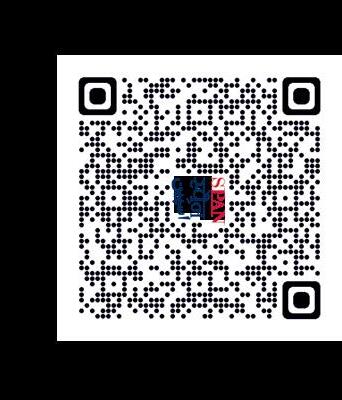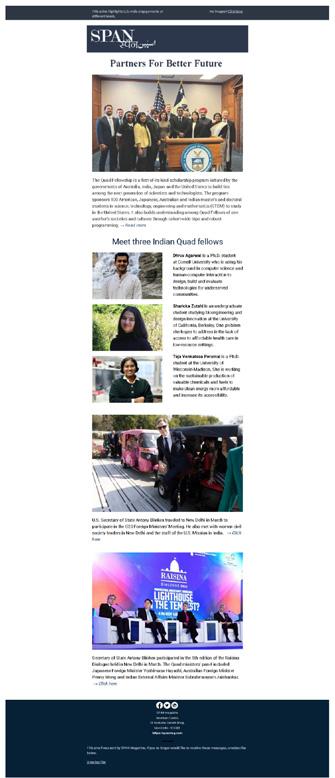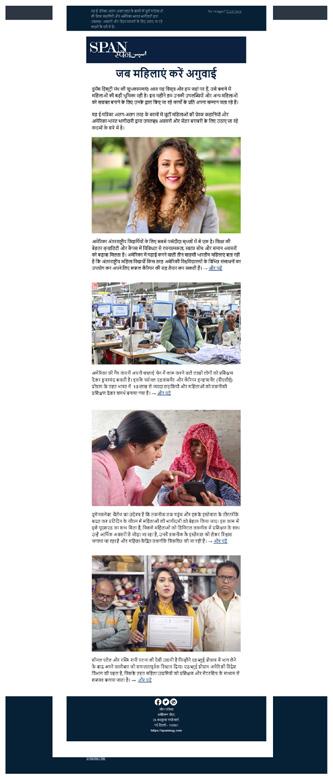SPAN
to Career
A (S)Quad of Good Fellows
Where Skills Meet Passion

to Career
A (S)Quad of Good Fellows
Where Skills Meet Passion
With a U.S. Degree
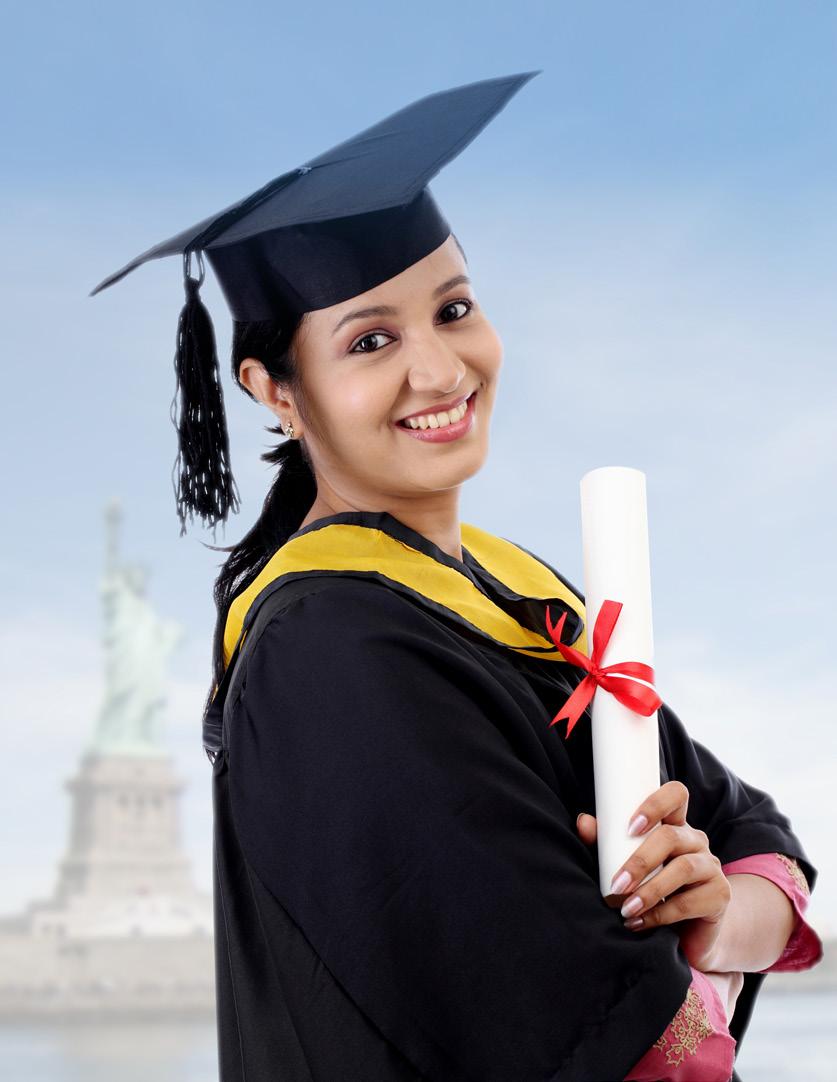

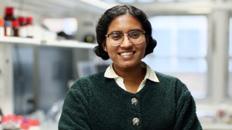



 By NATASA MILAS
By NATASA MILAS
The United States is the preferred higher education destination for students all over the world. According to the Open Doors Report 2022, almost 200,000 Indian students chose the United States to pursue higher studies in the 2021-22 academic year. U.S. universities offer highquality education and research opportunities, along with multicultural campuses. U.S. higher education can also be expensive. Fortunately, there are a range of financial aid options that international students at U.S universities and colleges can access.
With the right planning and research, students can access a range of financial assistance for higher education in the United States.
Websites of institutions list specific tuition and additional costs. When budgeting, it also makes sense to take into account that tuition costs might increase during the course of the studies.
EducationUSA advising centers are great places to get information on how to look for financial aid information. Advisers can guide students to stand out in a highly competitive applicant pool to increase their chances of receiving financial assistance. In addition, they can also share up-to-date information about financial aid opportunities.
Financial aid can be merit or need-based. Merit-based scholarships are offered to students for academic excellence. Needbased scholarships are primarily based on the student’s needs and can be in the form
of grants, scholarships, work-study positions or loans. These scholarships can include the entire package (tuition and living expenses), or only tuition or part of the tuition cost.
The University of Southern California (USC), for instance, provides financial aid to international students in the form of meritbased scholarships and on-campus work. International students at the university are not eligible for need-based financial aid.
“Trustee (full tuition) and Presidential (half tuition) are the top scholarships,” says Glenn K. Osaki, senior adviser to the president, international communications and marketing, at USC. “International students are eligible to be considered for these scholarships and the others if they meet the criteria indicated.”
Based in Los Angeles, USC has one of the largest populations of Indian students in the United States. Among many international students from India who received financial

Need-based scholarships can be in the form of grants, scholarships, work-study positions or loans.Above: The University of Southern California provides financial aid to international students in the form of merit-based scholarships and on-campus work. Right: At Amherst College, admitted international students receive a full financial aid package. Jupiterimages/PHOTOS.com/Getty Images
assistance from USC are Aanya Agarwal and Rudra Saigal.
Agarwal, a sophomore from New Delhi, is double-majoring in cognitive science and narrative studies. She is a Leadership Scholarship recipient and works the front desk at the psychology department.
Saigal, a sophomore from Indore, is a Presidential Scholarship recipient and is majoring in political science. Saigal has recently been elected to the Senate on Undergraduate Student Government and receives a stipend for that role.
At USC, and many other U.S. universities, international students can work up to 20 hours on campus to supplement their scholarship and help cover costs of their studies.
“All on-campus jobs are available to international students, including jobs in the USC Bookstores, libraries, tech support, on-campus housing, fitness center, even
tutoring for the athletic department and other student groups, etc,” says Osaki.
Amherst College, a liberal arts institution in Massachusetts, offers need-based financial aid for international students.

Admitted international students receive a full financial aid package. “Once admitted, Amherst College provides financial aid to meet 100 percent of admitted students’ calculated financial need without loans,” says Xiaofeng Wan, associate dean of admission and coordinator of international recruitment at Amherst College. “In the 2022-23 academic year, 79 percent of international students received need-based aid, with an average aid offer of $76,739.”
U.S. universities also offer financial assistance to international graduate students. For instance, all applicants to Penn State
Law’s Juris Doctor program are automatically considered for scholarships, which can reach up to full-tuition. If students maintain a good academic standing, scholarships are renewed in the second and third years.
Revanth Ashok, who earned an LL.M. degree with a specialization in corporate law and practice from Penn State Law, advises prospective students to reach out to universities to learn about the availability of scholarships. “The process for applying for scholarships or financial aid in each law school will not be identical,” says Revanth. “If you have access to graduates from the university or law school you are applying to, make an attempt to speak with them as they would have a better understanding about the financial aid process as well as the prerequisites for qualifying for financial aid.”
Students can also get funding from other sources to study in the United States. “In 2019, I was awarded the Best Law Student of India (male) by the Society of Indian Law Firms and Menon Institute of Legal Advocacy Training. As a result, I received an offer to pursue LL.M. at Penn State Law with a complete tuition fee waiver (about $50,000),” says Revanth. “The award is given after completion of a process, which includes interviews, during the annual N.R. Madhava Menon moot court competition.”



Another option is the Aga Khan Foundation International Scholarships, which provide a limited number of scholarships each year for postgraduate studies to outstanding students from certain countries, including India, who have no other means of financing their studies. Priority is given to master’s-level courses but Ph.D. programs, when doctoral degrees are necessary for a candidate’s career, are also considered. Half of the scholarship is given as a grant and half as a loan, to support tuition and living expenses.
With these viable financial aid options, there is a plethora of opportunities to pursue undergraduate and graduate education in the United States as an international student. The main thing to keep in mind, along with planning one’s studies, is to understand and prepare for the financial challenges—and opportunities—that accompany international studies in the United States.
Natasa Milas is a freelance writer based in New York City.
1.
Gandhi Marg New Delhi 110001
2. Periodicity of Publication: Bi-monthly
3. Printer’s Name: C.J. Jassawala Nationality: Indian Address: Thomson Press India Ltd. 18/35, Delhi Mathura Road Faridabad 121007 Printer’s Name: Vijay Adlakha Nationality: Indian Address: Infinity Advertising Services (p) Ltd. Plot No.-171 & 172, Sector-58, Faridabad 121004
4. Publisher’s Name: Gloria F. Berbena Nationality: American Address: 24, Kasturba Gandhi Marg New Delhi 110001
5. Editor’s Name: Deepanjali Kakati Nationality: Indian Address: 24, Kasturba Gandhi Marg New Delhi 110001
6. Name and address of The Government of the individuals who own United States of America the newspaper and partners or shareholders holding more than one percent of the total capital:
I, Gloria F. Berbena, hereby declare that the particulars given above are true to the best of my knowledge and belief.
Date: April 19, 2023 Gloria F. Berbena
Signature of Publisher
EducationUSA advisers can guide students to stand out in a highly competitive applicant pool to increase their chances of receiving financial assistance.


The United States is one of the most sought-after destinations for international students. The high quality of education and diversity on campus cultivates creativity, independent thought and equal opportunity. Three Indian women, who studied in the United States and took advantage of wideranging resources at the universities to launch successful careers, talk about how international students can unlock amazing opportunities.
D’Souza, a music, technology and entertainment lawyer in Mumbai, graduated from the University of Southern California (USC). She runs her own law office, and helps international rock stars negotiate major contracts. But before she began striking deals, D’Souza knew that she had to gain deep knowledge in the areas of law that fascinated her.
“Media, entertainment and intellectual property—those were the fields I knew I wanted to focus on, and I didn’t think I could learn everything I needed to in India,” she says. “I applied to a few schools in the United States and chose USC because it had the best film school and offered a lot of the subjects I wanted.” The school’s proximity to Hollywood and powerful network of entertainment-industry alumni also played an important role in her decision.
As a practicing lawyer, D’Souza works on everything from licensing and sponsorships to performance contracts and record deals. She also assists clients navigate business matters like collecting royalties for their creative works.
“I love working with creative people,” says D’Souza. “Meeting artistes gives you such a fun perspective. If I show up to a meeting in a business suit, nobody will take me seriously— but if I wear a tank top and Jordans, everyone will talk to me. It’s still about business, but it can almost feel like a casual conversation with amazing, interesting friends.”
D’Souza wholeheartedly encourages students to take the leap if they get the opportunity to study in the United States. “Do it! Having an American degree has given me such a level up in my career. I would never have imagined that I would start my own law practice and have so much fun in my work, but because of the knowledge and experience I gained in the United States, I was able to do it,” she says. “In the world of law where I practice, if you don’t bring an edge to your work, nobody listens to you. And my degree from USC has been a great edge to have.”
D’Souza recommends that Indian women looking to study in the United States start searching for scholarships early in the process—instead of after they are admitted. Schools are often proactive about helping international students connect with financial aid, she says. “If you ask for help, the university will connect you with the right people to talk about scholarships.”
Many students worry about safety when they are far away from their families. D’Souza admits that staying safe in Los Angeles was a concern for her, but she says that USC did a great job of putting her mind at ease.
Among other measures, the school offered free transportation at night, security officers and emergency call boxes positioned all around campus, and even basic self-defense training from the Los Angeles Police Department. “I sometimes had classes until 9 p.m., and never really felt unsafe on campus,” she says.
D’Souza’s other concerns included locating adequate housing and getting into the classes she wanted. For both, D’Souza actively engaged with professors, alumni and administrators to ask for advice and help, and their prompt assistance helped her thrive on all counts.

Long before she began supporting Indian and American exchange students through her role at the United States-India Educational Foundation (USIEF), Mayreddy completed her own overseas adventure. A graduate of Virginia Tech, she currently works as a regional officer at USIEF in Hyderabad.

Mayreddy chose to apply to Virginia Tech mostly because of its ranking and financial support opportunities, all of which she learned about from the university’s thorough and informative website. “I also individually wrote to different faculty in my department to check if there were assistantships that I could be part of,” she says. “One of the professors had an opening that matched my interest, so I managed to get an assistantship for two complete years.”
Studying in the United States helped Mayreddy launch a career she finds exciting and fulfilling. “American degrees are recognized and respected around the world,” she says. “For me, it provided a strong foundation and opened up opportunities that would not have been possible otherwise.”
While pursuing her master’s degree in business and economics at Virginia Tech, for example, Mayreddy received an opportunity to intern with the World Trade Organization in Switzerland. She describes the experience as having a huge impact on her personally, academically and professionally.
“I believe this was possible only because of my educational background of studying in the United States,” she says. “It helped me become independent, confident and adaptable, and appreciate diversity. I was exposed to diverse perspectives and experiences, which have broadened my horizons in understanding the world and myself.”
Indian students hoping to pursue higher
studies in the United States can follow Mayreddy’s example and thoroughly research programs that align with their interests and career goals. “All the universities have websites that provide information on the application process, scholarships and resources for international students,” she says.
Mayreddy says her biggest fear about studying in the United States was the unknown. “Since I had never traveled to the United States before I went there to study, it was all new,” she says. “Initially, I missed my family and friends a lot, but in a few months, I got busy with studies and work. The first trip to India during summer break was badly needed. Once I came to India after the first two semesters and went back, I felt good, and it became home.”
Mayreddy always felt safe on campus, thanks to Virginia Tech’s rigorous security protocols, which now include a phone app that allows students to instantly call for assistance in case of an emergency.

She also found the flexibility of the American educational system challenging but rewarding. “In the United States, a student can pursue anything they are interested in as long as they meet the requirements of the course,” she says. “There is so much help and support given by the faculty to help students achieve their aspirations.”
Mayreddy also points out that contacting professors directly, as she did, can reveal opportunities for academic growth and financial support that prospective students might not otherwise discover. “Studying in the United States can be challenging and rewarding,” she says. “But with the right preparation, mindset and resources, it can be a fantastic opportunity for personal and professional growth.”
When Tibrewal first learned to serve, slice and volley as a competitive tennis player in Kolkata, little did she know that she was also laying the foundation of an exciting sports-related career in the United States.
Tibrewal, who has a bachelor’s degree in economics from Mount Holyoke College, is nearing the completion of a master’s degree in business administration and Master of Science in sport management at the University of Massachusetts (UMass) Amherst. She has already accepted a leadership position in the collegiate sports field, she says.

Such opportunities would not have been possible without a variety of scholarships to help Tibrewal along the way. She recommends starting early and reaching out proactively. “Many campuses are making a big push to be more diverse and to grow their international student population,” she says. “And colleges like Mount Holyoke are setting up more scholarships to support international students.”
Since Mount Holyoke does not offer scholarships based on athletic talent, Tibrewal says she received need-based and merit-based financial support to pursue her dream of working in the field of sports. She won additional scholarships from organizations outside Mount Holyoke, including the National Collegiate Athletic Association (NCAA).
“Mount Holyoke gave me endless opportunities for personal and professional
growth. These included being an active member of the Student-Athlete Advisory Committee, working various on-campus jobs to develop skills in working in professional environments, and holding student leadership positions,” says Tibrewal. As a junior, she was selected for four national NCAA student-athlete conferences. “Those experiences enabled me to meet other athletes from institutions across the United States, and learn from leaders within the NCAA National Office, as well as other athletic administrators that helped shape my worldview of the sports industry,” she says. Tibrewal will complete her graduate studies at UMass Amherst’s Isenberg School of Management this year. At Isenberg, she got the opportunity to hone her business skills through its hands-on curriculum and interactions with faculty who have extensive sports industry and consulting experiences. “UMass’ focus on real-world projects and experiential learning has given me the opportunity to not only widen my horizons but also better understand the sports industry and where I see myself in it,” says Tibrewal. “In addition, I found a support system that challenges, inspires and helps me improve every day. I will forever be grateful for all the doors UMass has opened for me and I can’t wait to start my full-time role at the National Association of Collegiate Directors of Athletics, post graduation.”
Parents, naturally, have a number of concerns when it’s time for their children to leave home to pursue higher education. These concerns are often heightened if pursuing higher education means moving halfway across the world to the United States.
From campus safety and food options to culture changes, parents worry about how their children will navigate life in a new country, coupled with the stress of completing their studies in a new academic system.
By STEVE FOX“There was some sort of stress in letting a 17-year-old go so far beyond his home,” says B.N. Thorat, who teaches at the Institute of Chemical Technology in Mumbai and has three children studying in the United States. “It certainly is a challenge for any parent to let their children go at such a young age.”
Like Thorat, most parents’ concerns also revolve around whether a U.S. education justifies the investment, housing and food options, educational and emotional support their children can expect, and whether they will be safe.

Parents deal with many concerns when sending children abroad for higher studies. Here are some resources to help navigate the transition.Right: B.N. Thorat with two of his children, who are studying in the United States. Courtesy Manmohan Thorat
Fortunately, there is a wealth of information available to parents and their children when they begin the search for the educational institution that suits them best. Often, a prime source of information is the websites of the universities they are considering.
The United States-India Educational Foundation (USIEF) offers regular sessions for parents and prospective students on various aspects of life as an international student at a U.S. university campus. It also helps connect alumni with students so they can share experiences with prospective students and their parents.

“We encourage parents to thoroughly research university websites, attend university information sessions and, if needed, write to the university to resolve their questions,” says Aditi Lele, who has counseled many families as an EducationUSA adviser with USIEF in Mumbai. “EducationUSA advisers are always ready to help parents navigate this process,” she assures.
Advisers say some parents prefer accompanying their children to their colleges to help them settle in, and understand what the first few days will look like. Bindu and Mayank Tewari, who sent both their children to the United States for higher education, say being on campus themselves went a long way in easing their anxieties. “We dropped the elder child off [at his university campus]. Being introduced, during orientation, to the
resources and the strong support system created for all freshmen—both emotional and academic—was very reassuring,” says Bindu. “Learning over time from our son that these systems actually work was further so,” she adds.
Safety on campus is one of the main concerns for parents whose children will be living on their own for the first time. Most universities have dedicated systems and frameworks in place to ensure incoming international students and their parents are at ease. For example, the Division of Public Safety and Security (DPSS) at the University of Michigan offers a fully accredited police force, event security and ride-alongs to its community. Websites of major universities often provide information on their overall security arrangements along with helpful information like the mission statement of the university police department, information on emergency helplines, campus contacts and annual reports on security statistics.
Large American campuses usually have several communities for like-minded peers and students. For Indian students, the Indian Student Association is like a home away from home. From helping new students settle in to ensuring they have free food during finals, the association is known to take care of its student community. They also organize cultural dance competitions and celebrate Indian festivals to ensure Indian students do not feel homesick. Similarly, the North American Association of Indian Students, a nonprofit organization, connects a variety of Indian groups on college and university campuses to create better resources for Indian students.
Universities also inform their international students about key services and resources during orientation programs. While all change is challenging, Bindu ensured she was available for her child during the first few weeks of settling in. “The initial weeks are a challenge, so keep your lines of communication very open,” she says. “When the frequency of calls drops, rejoice! Your kids have now settled down!”
Large American campuses usually have several communities for like-minded peers.
Indian students planning to pursue higher education in the United States are often uncertain about a number of factors during their research and application process. These can range from the right time to apply and the application process to scholarships and return on investment.

Check out answers to some of the questions frequently asked by students.
Should I pursue undergraduate
studies in the United States or wait to apply for graduate studies?
I faced a similar question at the age of 17. I decided to take the leap of faith and accepted a spot at The College of Wooster in Ohio because there was no guarantee that I would have financial and family backing a few years later, if I had waited to apply for graduate studies.
As an EducationUSA adviser, I realize now that undergraduate studies prepare you for a strong graduate
application that may fetch you full funding based on merit. A U.S. degree provides you with
• research opportunities,
• practical learning projects,
• opportunity to build strong relationships with professors who will write recommendations, and
• exposure to a career and alumni network that will help you articulate your goals in the statement of purpose.
Graduate recruitment is done
An EducationUSA adviser answers questions frequently asked by students.EducationUSA adviser Unnati Singhania addresses a group of students from Gauhati University.
by departments. If you are familiar with them, they are more likely to admit you for graduate studies, especially with the 3+2 integrations where, in five years, you can get both undergraduate and graduate degrees.
Some students wait to apply for graduate studies, expecting more scholarships. But note that scholarships are department-specific and depend on the nature of the program. Connect with your nearest EducationUSA student advising center to get personalized advice.
Who gets priority for graduate funding?
Graduate funding is merit-based. Students can apply for two types of university-based scholarships—assistantships and fellowships. Assistantships can be of three types:
• Research assistantship, where you help a faculty member with their research;
• Teaching assistantship, where you teach an undergraduate class on behalf of a faculty member; and
• Graduate assistantship, where you do clerical work for the department.
Fellowships are awarded to stellar students to take their research forward. They get an entire tuition waiver, a living stipend and a portion of health insurance waived.
However, graduate students of researchbased programs are more likely to get full funding than those of course-based programs. This is also department-specific— science, technology, engineering and mathematics (STEM) fields get priority for funding. Deadlines for scholarships and grants can be as early as 18 months before the program start date. Before you submit your application, research independent scholarships, and identify universities with financial aid in your field of study.
• Why do you want to study in the United States?
• Where will you fit in best?
• Which colleges or universities will meet your needs?
• Will you need financial assistance?
• What are the application and financial aid deadlines?
• Where do you want to live in the United States?
(Source: https://bit.ly/Your5Steps)
Contact professors in your department of interest since they play an important role in choosing grant and funding recipients in their departments. Students also finance their studies through low-interest loans and external scholarships.
Are extracurricular activities important for graduate school applications?
For graduate applications, students need to showcase experiences specific to their field of study in their résumé. This includes educational background and awards, research, relevant internships or job experiences, special technical skills, language skills and community service. Extracurricular activities may help admissions officials dig deeper into your personality and the diversity you bring to the classroom, but may not be the defining factor for admission decisions.
How important are admission test scores for applications to U.S. universities?
Many undergraduate colleges and some graduate departments in the United States are test-optional, which means they have waived the SAT/ACT or GMAT/GRE aptitude test requirements. In this case, the student’s entire academic strength will be judged based on transcripts or marksheets. If students are confident that their marksheets are better than those of the average students at the university or are in the top range, they may forgo submitting this test score.
Do check the official college website to determine if you require a test score. However, test-optional does not include waiving the English proficiency test score requirement (TOEFL/IELTS/Duolingo/PTE). International students are still required to submit this score.
Why should I choose a U.S. education?
In the academic year 2021-22, almost 200,000 students from India chose the United States as their higher education destination, according to the Open Doors Report. The reasons include the flexibility of U.S. education, varied resources, vibrant student and campus life, research, scholarship and internship opportunities, comprehensive support services and a diverse student body. These opportunities allow students to become global citizens who are valued by employers and academic departments around the world.
Undergraduate studies prepare you for a strong graduate application that may fetch you full funding based on merit.
 By JASON CHIANG
By JASON CHIANG
Be it for prospective students or lifelong learners, MOOCs offer unprecedented access to quality education.
Traditional classrooms are limited in how many students can enroll, but there are millions of learners around the world who are looking for more ways to access quality course material, upskill or explore new domains.
“Recent trends suggest that Indian learners are increasingly recognizing the needs of the digital economy and building future-proof skills,” says Raghav Gupta, managing director, India and Asia-Pacific, at Coursera. In addition, Coursera has noted a rising uptake of courses related to professional certificates, “which are designed to prepare learners without a college degree or technology experience for a wide range of high-demand digital jobs.”

Launched by Stanford University professors Andrew Ng and Daphne Koller in 2012, Coursera is a provider of massive open online courses (MOOCs). Millions of people utilize MOOCs for different reasons, including college preparations, career development, changing careers, supplemental learning, lifelong learning and training.
“My love for science fiction and the workings of the modern world came together in a University of Michigan MOOC, titled ‘Fantasy and Science Fiction: The Human Mind, Our Modern World,’ on Coursera,” says Suparna Mukherji, a public engagement specialist at the U.S. Embassy New Delhi.
“It helped me analyze several great works of literature and explore their significance and contribution to the development of the world, both cultural and physical—all using my personal device(s).” The course offered a mix of readings, video lessons and prerecorded refreshers, written assignments, forums to read and comment on writings by other participants, and voluntary multiplechoice activities. “While I delved into literary history, psychology and culture regularly over several weeks, I formed great bonds with fellow participants from across the world. The MOOC also offered a glimpse of the incredible choices of courses U.S. universities offer and the engaging communities they help build,” she adds.
Most MOOCs are created by universities. Some of the first and most active MOOC makers are Stanford University, Massachusetts Institute of Technology (MIT) and Harvard University. However, the universities rarely distribute MOOCs themselves. Instead, they rely on digital learning platforms like Coursera and edX to offer the courses to online audiences.
In 2015, for the first time, learners earned college credit for MOOCs

on edX. Both Coursera and edX have worked on expanding collaborations with partner universities to increase the number of MOOCs that offer accepted credits into college degree programs.
The online learning and the opportunity to interact with fellow participants make MOOCs not only a platform for professional development but personal growth too. “I find MOOCs an easy space to navigate and convenient. One course I enjoyed completing was International Women’s Health and Human Rights offered by Stanford University,” says Sentirenla Asung, who is part of the Public Diplomacy team at the U.S. Embassy New Delhi. “Although online, I had the opportunity to have written discussions with peers in the course, which was interesting. This course raised my awareness and helped me be a better advocate for women’s rights and myself.”
One key impetus to the growth of MOOCs came during the COVID-19 pandemic, which accelerated digital transformation and changed the way people work and learn.
“In India, we have added over 14 million learners since January 2020—this is the highest number of new learners globally,” says Gupta. “A heartening trend is also the increasing number of women learners. In 2022, 44 percent of new learners in India were women, up from 37 percent in 2019.”
“Thousands of learners, educators and companies from around the world flocked to edX.org, and our network came together to help them stay connected, move forward and keep learning,” says Amit Goyal, edX’s group head for India and Asia-Pacific. “We welcomed 10 times more new registered learners and saw a 15-time increase in course enrollments.” edX was founded in 2012, when MIT professor Anant Agarwal and his colleagues from MIT and Harvard envisioned an experimental platform that could offer their courses online, open to any person, for free. Professor Agarwal taught the first edX course on circuits and electronics, which drew around 155,000 learners from 162 countries. edX now hosts online university-level courses in a wide range of disciplines for students across the

world, including some courses at no charge. Over 41 million learners and over 160 partner institutions use edX to increase access to highquality education.
In November 2022, edX announced a collaboration with Emeritus, another provider of online classes. The partnership will provide access to a specialized catalog of courses to millions of edX learners across India, Latin America and Asia-Pacific. After the United States, India is edX’s second-largest market in terms of registered users.
Over 1,100 higher education institutions in India have leveraged Coursera for Campus to improve graduate employability, bridge the industry-academia gap and help faculty upgrade their skills.
“With the government propelling the adoption of online learning, allowing 40 percent of credits in any category to be earned through platforms like Coursera, we’re excited about this momentum spreading across the country and supporting more universities and colleges to build India’s young and competitive workforce,” says Gupta. “Through the high-quality blended learning options, institutions will be able to arm their students with in-demand skills and help them identify new pathways into well-paying jobs.”
People utilize MOOCs for college preparations, career development, supplemental learning, lifelong learning or training.
 By STEVE FOX
By STEVE FOX
Can young college students be expected to know what career they want? Would it be better to give them time to explore different subjects before making a commitment? Is it possible that they will want to study more than one major?

Universities in the United States understand some students find it challenging to commit to one field of study right at the outset. This is why they offer flexible curriculums, which enable students to tailor their coursework and academic experience to their individual interests, goals and schedules. Students at four-year universities usually sample a variety of courses in their first two years before choosing a primary field of study, known as a “major,” along with a “minor” that might complement their major.
“Students can also change their major if they find that the major they originally set out to study is not the one they are truly passionate about,” says Deborah Rosario, senior EducationUSA adviser at the United States-India Educational Foundation (USIEF) in Mumbai. “Students can also enter a university ‘undecided’ or ‘undeclared,’ experiment with different courses to start with, and select a major later on. In some subjects, students also can create their own majors with guidance from a professor at the university.”
A flexible curriculum offers a number of other benefits. Students can:
• Explore different subjects and determine their areas of interest before committing to a major. This can help them narrow down their options and make more informed decisions about their future.
• Deepen their knowledge in their major by taking elective courses in their chosen field of study in addition to those required for their major.
• Create a customized interdisciplinary major by combining courses from different departments to fashion a program that reflects their individual
goals and interests.
• Explore a minor in a subject that interests them, which can provide them with additional knowledge and skills.
• Pursue independent research projects under the guidance of a faculty member to gain research experience and contribute to their field of study.
• Work toward two degrees at the same time. For example, an engineering degree and an environmental sciences degree.
• Gain practical experience through internships or co-op programs in their field of study.
• Reduce the stress and anxiety often associated with making a permanent decision about their future careers.
• Get a well-rounded education and enhance versatility, which can be beneficial in the job market. Employers value graduates who have broad-based knowledge and skills in multiple areas. Flexible doesn’t mean random. Universities that offer flexible curriculums also provide students with a strong educational foundation.

“In the United States, many fouryear universities follow a liberal arts curriculum in the first two years where students are required to take a range of courses in various disciplines such as humanities, natural sciences, social sciences and mathematics,” explains Sujana Mayreddy, regional officer with the USIEF in Hyderabad. “This approach provides students with a broad-based education, helping them to develop critical thinking, writing and communication skills.”
It’s also important for students to explore ahead of time whether a university offers a flexible curriculum and just how flexible it is. Some colleges follow a formula while others allow students to essentially design their own course of study.
Students can:
• Explore different subjects
• Deepen knowledge of majors
• Create customized interdisciplinary majors
• Work toward two degrees at the same time
• Pursue independent research projects
• Pursue internships or co-op programs
• Enhance versatility
• Build critical thinking abilities
Flexible curriculums at U.S. universities allow students to make informed choices about their subjects and career paths.Feodora Chiosea/iStock/Getty Images
For international students at American universities, adjusting to a new educational culture can be a challenge. Adapting to a new and competitive work culture after graduation can be equally daunting. With this in mind, U.S. universities offer a vital resource to help students transition from school to the working world—career services.
Priyanka Raut, a counselor at the University of Houston’s career services office, says they help students understand what the American workplace is like, what recruiting practices are for any given field, and “the very important difference between a résumé and a CV.”
“We also help them understand how to interview, search for jobs and internships, and make themselves relevant to the market they’re looking at for jobs,” she says.
In certain fields, paths to a promising career in the United States can look very different than in India. “In India, if you want to be an engineer or a doctor, you have to pass an entrance exam to get into a good school, and your scores are the only thing that determine your school,” says Raut. However, she says, in the United States, universities and employers look at many factors when choosing candidates. There is also more flexibility for those who want to change their subjects or career paths.
Working with career services can help students effectively present not just their technical accomplishments to employers, but soft skills like communication abilities, teambuilding, and negotiating as well.
“Based on my interactions with international students from India, a CV is
considered to be the same as a résumé,” says Raut, “but in the United States, they’re very different documents. A CV is more focused on researching, teaching and publications, while a résumé focuses on internships, extracurriculars and skills. It’s very important for Indian students in the United States to understand the difference.”
Nirmita Roy, an electrical engineer who is currently studying for her doctorate at the University of South Florida (USF), took advantage of her university’s career services to craft a résumé that would grab employers’ attention.
“In India, you put every single detail, every project you’ve worked on [in the résumé],” she says. “I wasn’t sure how concise I was supposed to be, given my field.” She says her friends who work in the finance and business sectors had one-page résumés. “But was that true for me, too? I didn’t know who to ask, until I reached out to career services.”
Roy was thrilled with the help she received. “They looked up my background and gave me a coach who knew about careers and employers in electrical engineering, and who met with me one-on-one to answer my questions,” she says.
Ariadne Cheng, associate director for International Student Career Engagement at the University of Southern California, advises applicants to tailor résumés for the position they want. “Look at the job description and find the key skills, qualifications and even personal qualities that are listed for the position,” she says. “Highlight the ones that you have, and then make sure that all those points stand out in your résumé, both in the skills section and in the descriptions under your experience.”
Cheng further advises that students
Career services at U.S. universities guide international students on how to present their best selves to potential employers.
Top and above: University career services offices often organize career fairs, talks, receptions and other events where students can interact with potential employers.

describe their professional, educational and volunteer experiences in an individualized way. “Whenever possible, try to quantify or demonstrate your impact in some way,” she says. Using specific numbers or milestones to show how important your efforts were is a great way to go, she adds.
“Career centers put a lot of work into building relationships with employers so that those employers can serve as a resource for students,” says Cheng. “International students from India should take advantage of the opportunities provided by their career center to connect with and learn from these employers directly.”
Career services offices often put together career fairs, talks, receptions and other events where students can interface with potential employers. Students should also take advantage of school mentorship programs and apply to those for which they are eligible,

Cheng advises. “Adjusting to college life can be hard, especially for international students, and having a mentor who has been through it to help guide you can make the experience so much easier,” she says. “Even if your school doesn’t have a formal mentorship program for international students, don’t be afraid to reach out to alumni—you may be pleasantly surprised to find they are happy to help and offer advice.”
Roy advises Indian students to take advantage of any and all opportunities career services make available. “Even the smallest career services workshop can help you, and it’s already covered by your tuition, so you really don’t have a reason not to go,” she says. “It can be a stepping stone to get you started on your career. Especially if you’re from another country, career events can help you get over culture shock, learn how to talk with employers, and really get a grip on how things work in the United States.”
Whatever your career path may be, Cheng says, it’s never too soon to visit your school’s career service office and start planning.
“As an international student, you have more to think about when job- and internshipsearching because of U.S. immigration laws. So it’s best to begin familiarizing yourself with the process and planning your career path early,” she says. “Your school’s career center will have resources for every step of your career path, from major and career exploration all the way to job offer negotiation, so you don’t have to do any of it alone.”
U.S. universities help students build interdisciplinary skills through specialized majors like object design and sports management.

Majors in STEM fields and business are the most common programs selected by Indian students in the United States. However, American universities also offer many niche programs that are perfect for international students who are passionate about pursuing a future in a specialized industry that combines interdisciplinary skills with their unique set of interests.
For more than 155 years, the School of the Art Institute of Chicago (SAIC) has helped shape the next generation of influential artists and designers. The institute provides an interdisciplinary
approach to art and design with Chicago’s world-class resources, museums and architecture. Students are encouraged to create bold ideas while exploring different disciplines to hone their creativity and skills.
It was the freedom to explore disciplines that intrigued Anavi Nugyal from Mumbai, when she was researching different types of education systems that would best fit her interests. “I was looking for an interdisciplinary course that would allow me to develop my vague interest in the creative world, and better understand its potential,” says Nugyal, who graduated from SAIC with a Bachelor of Fine Arts degree in designed objects. “The School of the Art Institute of Chicago offers a unique
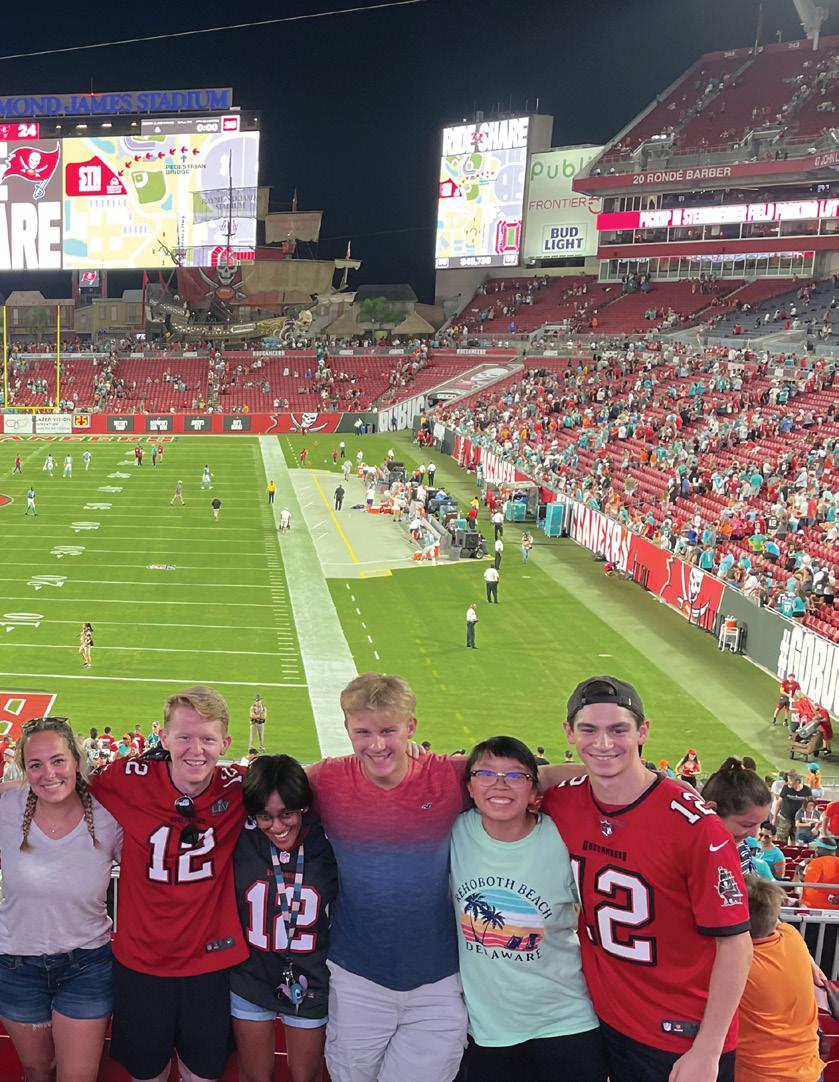
interdisciplinary program, with no majors and access across different disciplines in the creative world and that is what made me apply and commit.”
Designed objects, which falls under the Architecture, Interior Architecture and Designed Objects Department, is an interdisciplinary field where product design, space design, UI/UX (user interface/user experience) and social design meet. Students develop critical skills to imagine and create meaningful objects, systems and experiences through a structured curriculum. “I found my introductory class to be very enlightening and it helped me focus and take more courses within the department,” says Nugyal. “During this time, I was also taking classes in fiber and material studies, art and technology, fashion, and various liberal arts courses that helped me better my practice and develop stronger projects.”
Nugyal began attending virtual sessions hosted by SAIC’s admissions team when she was in the 11th grade. She also reached out to a faculty member to learn more about the classes and followed the institute’s social media. She later applied to SAIC by the school’s early action deadline and was overjoyed when she was accepted.
Nugyal received several scholarships and grants that helped with the cost of living and tuition. She also worked as a residence adviser on campus to help cover her housing, food and supply costs. “I really recommend using all the resources, and pushing for what you need,” she says.
Graduates from SAIC work across multiple diverse disciplines. “I think the unique education equips graduates to apply their skills in many different industries. There are alums I know in straightforward UI/UX positions, alternatively many are working within tech and think tanks,” says Nugyal, who works as a freelance designer across film, theater, UI/UX and social impact design.
“Personally, I am interested in many fields and find joy in developing my own practice for shows, and also work freelance in various projects that interest me,” she
adds. “My dream career is to be able to retain that freedom, to be able to apply design and critical thinking in the social sector, and use the skills I have to help with city planning and problem-solving, and also be able to develop a project in theater about climate change.”
The University of South Florida (USF) graduate program for sport and entertainment management emphasizes the business fundamentals that are needed to work in the world of sports. The Vinik Sport and Entertainment Management (VSEM) program is a two-year dual-degree program where students earn both an M.B.A. with a concentration in sport business and M.S. in sport and entertainment management.

“In the two years of the program we learn about the business management of the sports industry in the United States and, at times, we collaborate on projects for international entities like a football club from Europe or an entertainment entity like MGM Resorts,” says Gopi Patel, a national medalist gymnast, who grew up in Vadodara. Students also travel to national and international locations for presentations and networking within the sports and entertainment industry. “Our course focuses on marketing, sales, partnerships and analytics for a league or a team within the league,” she says.
The VSEM program accepts applications online, where students are required to upload their résumé, a statement of purpose, recommendation letters, transcripts, as well as a video about themselves and why they are interested in the program. International students, like Patel, must also submit a TOEFL score or other proof of English proficiency. Financial aid is also available for the program—Patel received a tuition waiver for her final two semesters, as well as fellowships through USF.
There are multiple career paths graduates of the program might choose in either pro sports or collegiate athletics, including the community impact side of a sport, and sports and entertainment commissions of different
The VSEM course focuses on marketing, sales, partnerships and analytics for a league or a team within the league.
cities. Each student is required to have at least one semester’s worth of fellowship experience in order to graduate with an M.B.A. after the first three semesters. Students also need to have fellowships for three semesters in total, one being the summer break, to graduate with both M.B.A. and M.S. degrees. Due to her undergraduate studies in photography and visual arts, Patel was drawn to social media in sports. “I am doing all my fellowships in the social media department either as an analyst or content creator,” she says.
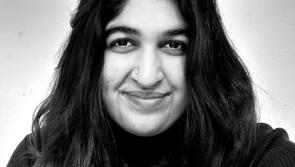
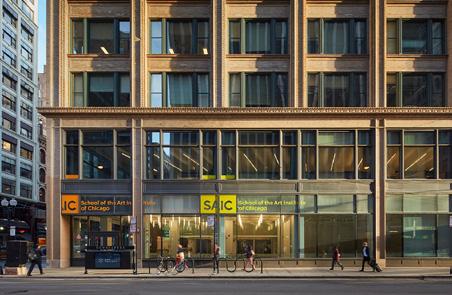
The VSEM program places students directly inside a professional sports setting, where they can experience how the lessons taught in the classroom play out in the field. Students attend classes for two days and work three days per week as a fellow or intern with program partners, including pro teams, NCAA teams or sports commissions, in the Tampa Bay Area. “In the first year I worked for Tampa Bay Lightning as a social media strategist, archivist and analyst,” says Patel. “I am currently in the second year and I am working for USF Athletics’ social media department as their digital content creator.”
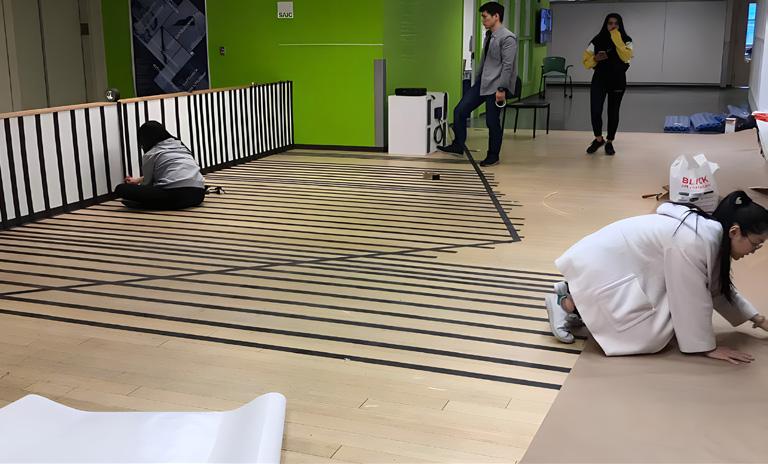
International high school students who want to pursue undergraduate education in the United States can get a taste of college life before enrolling in a full-fledged university program. Summer high school programs, like the ones at Boston University, Brown University and The University of Chicago offer an immersive pre-college experience, as students live on campus and take in-person classes, or register for summer online courses.
Each campus employs its rich resources to offer high school students college-level academic programs in sessions ranging from two to seven weeks. These programs are a great way to experience the in-and-outs of undergraduate studies. Students can concentrate on learning without the pressure of formal grades with non-credit courses, or even get a head-start on college admissions by earning academic credit.
During the course of the pre-college programs, high school students make lasting connections with fellow students and professionals from around the world, as did Arnav Garg from New Delhi and Atharva Shukla from Bengaluru.
Atharva recounts his time at the summer course as highly “engaging and productive.” In 2022, he joined an in-person credited summer course, Physics of Stars, through The University of Chicago’s astrophysics department. “Richard Kron [professor emeritus, Department of Astronomy and Astrophysics] and three graduate students taught us the essential concepts of physics, mathematics and astrophysics,” he says. “What I really appreciate was their willingness to go above and beyond the requirements of the course to answer our questions as we did a simulation of the orbit of the Sun and Moon and completed a group project on particle physics about the Theory of Supersymmetry.” For him, the highlight of the course was an excursion to the world-renowned refracting
Yerkes telescope.
Arnav completed The University of Chicago’s online summer course, Pathways in Economics, for credit in 2021. It was a rigorous study of microeconomics, macroeconomics, game theory and consumer theory. His class of 70 multinational students was divided into groups of 20, taught by different professors from the university’s Department of Economics.
Next year, in 2022, Arnav participated in a summer session on The University of Chicago campus with eight other grade 10 students who had qualified for the course titled Introduction to Special Relativity.
“A graduate student from Harvard University, Nick Aggia, taught the course and made the abstract ideas of Einstein’s relativity theory quite simplistic for us,” says Arnav. “The teaching, homework and interaction with peers made those three weeks the most engaging and productive of my life.” He notes his favorite segment of the course was the last two days when they studied black holes and time travel.
The University of Chicago offers six pre-college programs to international students, delivered both online and in person. The Summer Immersion program offers undergraduate-level courses taught through workshop discussions, research projects and other hands-on activities.
The subjects in this program range from STEM (science, technology, engineering and mathematics), biology and economics to media, creative writing and computer coding. Other programs, like the Summer College, can be accessed as a residential student or online.
The University of Chicago also offers financial aid to incoming international students. While the amount of aid varies based on need and program cost, the university offers a limited number of full and partial financial aid packages for the Summer Immersion program. Full financial aid will cover costs for tuition, housing and dining.

Summer courses let high school students experience life in U.S. universities, without the academic pressure.Courtesy Arnav Garg
Each year, high school students from around the world take advantage of programs such as Boston University Summer Term’s pre-college programs.

Students in grades 10 and 11 can apply for the six-week High School Honors program and select from more than 80 courses for college credit. They can enroll in the university’s three-week Academic Immersion program to study experimental psychology, medicine or creative writing.
The university also provides a two-week, two-seminar Summer Challenge for students of grades 9, 10 and 11, as well as the Summer Preview program, a one-week seminar for 7th, 8th and 9th graders.
“Boston University’s pre-college programs showcase all that our top-rated university and the city of Boston have to offer,” says Amanda Kautzman, associate director of Boston University Summer Term’s high school programs. “Students get an introduction into college academics and college life, helping them to explore their future academic interests.”
Brown University’s pre-college program for high school students, Summer@Brown, offers more than 300 non-credit courses. The university offers two additional on-campus programs: a STEM program for incoming 9thand 10th-grade students, and a Leadership Institute for students interested in sociallyresponsible leadership. Additionally, Brown’s online Pre-Baccalaureate Program provides incoming grade 12 students opportunities to study alongside Brown undergraduates in seven-week courses for credit.
Aninditha Goel from Mumbai enrolled in Brown University’s Engineering Design Studio course with 15 other students in 2022.

Her initial assignment was an engineering project for a case study of a real-life disaster. She then joined a group of three, which was assigned to make an adjustable piece of furniture. “After a brief session on laser design and cutting, we used the equipment to create a coffee-dining table that transformed into a student desk,” says Aninditha.

As might be expected, the high school students faced challenges and acclimation for their immersive college-life experience. “I’ve spent my life interacting with people of the same nationality and college life was a very different experience for me,” recounts Aninditha. “Brown provided a lot of social activities and excursions. We went to a baseball game, which I don’t follow or understand. But it was a new experience and my second time going to a sporting event.”
“My experience in UChicago was eyeopening,” says Atharva. “I had to learn a lot based on first-hand experience, figuring out restaurants, dealing with the culture and doing my own laundry.” Arnav says the summer course on relativity encouraged him to interact with fellow students on homework after lectures. “I made great connections with other U.S. and multinational students,” he says, “and I’m still in contact with friends worldwide, online or by phone.”
Students live on campus and take in-person classes, or register for summer online courses.Hillary Hoppock is a freelance writer, former newspaper publisher and reporter based in Orinda, California. From above far left: Arnav Garg, Atharva Shukla and Aninditha Goel made new connections and experienced American culture during their pre-college summer courses at U.S. universities. Courtesy Aninditha Goel Courtesy Atharva Shukla
U.S. universities provide a range of support services for international students with disabilities.

Studying abroad can be a gratifying educational and cultural experience, but it could also come with challenges. Potential barriers include the complex application process, financial needs, and acclimatizing to new academic and cultural environments. Students with disabilities who wish to study abroad may encounter additional challenges.
“These challenges may include navigating a new and unfamiliar system, cultural and language barriers, and limited resources or services that are specifically tailored to their needs,” says Sujana Mayreddy, regional officer at the United States-India Educational Foundation (USIEF) in Hyderabad. “Students with disabilities might require expensive accommodations or assistive technology to succeed in college. Without sufficient financial support, they might not be able to afford to attend the institution of their choice.”
Indian students with disabilities planning to pursue higher studies in the United States may reach out to an EducationUSA adviser for help to navigate the application process and find the right fit—a university that can meet their academic and disability needs.

“While researching for right-fit universities, you can find out what services are available for persons with disabilities at a particular campus,” says Aditi Lele, EducationUSA adviser at USIEF Mumbai. “Accredited universities are fully equipped
with resources for students with disabilities.”
In addition to finding the right fit academically, students with disabilities “should communicate their needs and concerns with admissions staff and disability services offices,” says Mayreddy. This ensures that the institution provides the necessary support.
Many U.S. universities have disability services offices or other support programs that provide accommodations and a range of services. “These may include assistive technology, note-taking services, accessible housing and transportation, and academic accommodations such as extended time on exams or alternative testing formats,” says Mayreddy.
Student organizations may be a useful resource too. “International students may find support from campus student organizations and other disability advocacy groups that help them connect with resources and build a supportive community,” Mayreddy adds.
Carleigh Kude, director of disability advising at Stanford University’s Office of Accessible Education, says, “We have a team of highly skilled professional service providers who work directly with students to provide individualized accommodations. We also work closely with our campus partners such as the student health center, housing and dining, career services, and academic departments to ensure that students with disabilities receive equal access to

opportunities in all aspects of life at the university.”
There are various levels of support provided by the Office of Accessible Education. “International students are entitled to the same disability rights and support services available to domestic students, but we recognize that this is a unique group that requires unique considerations. Students from outside the United States might not be familiar with special accessibility accommodations and options in the postsecondary educational environment,” Kude explains. “Knowing this, we are sure to promote our services at international student orientation events. We are mindful that it might take additional levels of support to get the disability-related services they need so that they can be successful students.”

The Office of Accessible Education regularly hosts community events and information-sharing workshops. “We also share a building with the Disability Community Space (DisCo), a student-led place where peers can meet, network, share experiences and build friendships,” says Kude.
This summer, postsecondary disability services providers from around the world will meet in Kerala at a conference where Kude will present a session on transitioning to U.S. colleges for international students with disabilities.

One of the strengths of American higher education is the variety of universities and colleges. There are public and private institutions, very large and very small, secular and religiously affiliated institutions. There is also great diversity in settings—the institutions are based in urban, suburban or rural locations.

According to the U.S. Department of Education, there are 3,931 degree-granting higher education institutions in the United States. Public institutions have the largest enrolment rates since they tend to be larger than private institutions. Private schools are not funded by the government, but by donations, endowments and tuition payments. Nearly three quarters of private institutions are nonprofit.
The majority of colleges and universities offer four-year undergraduate degree programs. Universities also offer graduate and Ph.D. programs. Community colleges offer two-year programs, which are less theoretical and more career-oriented.

are generally smaller than public universities, often with smaller classes, and tend to be more expensive. Some of the most wellknown universities in the United States, like Harvard, Yale, Brown and Princeton, are in this category. In addition to receiving donations and student tuition payments, these institutions have endowments—fortunes that are carefully invested and produce interest income for the university every year.
The United States is home to diverse types of higher education institutions to fit every academic and career goal.
are managed and funded by the U.S. state in which they are located. Each of the 50 U.S. states has at least one public university. Often, they are part of a larger state university system. The State University of New York system, for example, is made up of 64 different public institutions, from top research universities to colleges of technology to community colleges. Most of the bigger universities in the United States are public. The biggest—Texas A&M University—has enrolled more than 70,000 students every year since Fall 2020. Students from the state where the university is located pay a lower tuition than students from other U.S. states or other countries.
educationusa.state.gov/ videos/how-many-types-usuniversities-are-there
Below: A public research university, University of California, Los Angeles, offers degrees and doctoral programs to 31,600 undergraduate students and 14,300 graduate and professional students.

amherst.edu

brynmawr.edu
are private, nonprofit and offer programs in the humanities, sciences and social sciences. They have smaller classes and typically focus on providing a well-rounded undergraduate education leading to a bachelor’s degree, rather than carrying out research.
degrees in arts, humanities, sciences and social sciences. A residential women’s college at the undergraduate level, it has coeducational graduate programs in arts and sciences, in social work, and in post-baccalaureate premedical training.

mostly offer two-year associate degree programs. They also offer the least expensive form of post-secondary education. Some students do a two-year degree to prepare for a lower-to-midlevel job in a particular field. Many others attend a community college as a stepping stone to transfer to a four-year college to earn a bachelor’s degree.

offer specialized training in various industries or careers. The training, which usually results in a two-year associate degree or a shorter certificate, is the most practical and the least academic of all forms of higher education. Study programs cover a wide range of specialties at different schools, including areas like culinary arts, firefighting, fashion design, construction skills, dental hygiene and medical-records keeping. These schools can be public or private. The sector includes a considerable number of for-profit private schools.

The San Francisco Conservatory of Music (top and above), a private institution in California, offers bachelor’s and master’s degree programs in composition, and instrumental and vocal performance.


sfcm.edu
focus on the arts. In addition to coursework, they generally include intensive practical experience in the school’s area of focus, such as playing music, producing visual art, theater or photography. Most of these colleges offer associate or bachelor’s degrees in the fine arts or a specialized field. They often educate young people who will move into the top ranks of their field, such as symphony orchestras and professional theaters.
Burton Bollag is a freelance journalist living in Washington, D.C.
U.S. community colleges attract international students with their competitive exposure, support services and easy university transfers.


For international students, community colleges are often viable options for the diversity of opportunities and support they provide to students.
Rushil Sharma, an alumnus of Green River College (GRC), a public community college with its main campus in Auburn, Washington, is a case in point. “Archaeology was the only major I was ever interested in,” he says. “However, at GRC, I discovered I also had a penchant for dramatics.” He participated in many volunteer activities and took on-campus paid jobs. “As vice president of Peer Volunteers, I developed leadership skills and my trips to Native American reservations helped me appreciate anthropology,” he says.
Community colleges are two-year institutions that offer a variety of certifications, technical degrees and certificates, and a limited number of four-year degrees. They are also more affordable and offer personalized interaction with faculty, thanks to small class sizes.
Adnan, a student at Lake Tahoe Community College (LTCC), says the clear academic career path that his academic counselor has drawn up for him will help him major in computer sciences and cybersecurity, and transfer to a four-year university to pursue a bachelor’s degree in information technology.

He has also been able to get on-campus work experience while studying. “I work on campus for the Student Life program as a student ambassador, assisting other students,”
he says. “I learn a lot about the college and the campus, and how to help new and current students navigate the class registration process and make their overall experience easier and better.”
Lake Tahoe Community College awards approximately $215,000 in scholarships annually, which international students are eligible to apply for after successfully completing their first quarter. “Additionally, the overall tuition cost here is noticeably lower than at other U.S. colleges and universities,” says Marta Sternal, international program coordinator and the principal designated school official for F-1 students, at the college. “For example, tuition for one full academic year at LTCC costs approximately $11,500 for international students, whereas tuition for one full academic year at a University of California campus costs upwards of $40,000.”
International students at Lake Tahoe Community College also receive financial assistance in other, indirect, ways such as through access to the on-campus food pantry, free shuttle transportation, and free textbooks and laptop loaners available through the library. “LTCC is also unique among community colleges in offering student housing that is priced well below market rate,” adds Sternal.
De Anza College, a public community college in Cupertino, California, does not offer scholarships for new students in the

Above left: There are over 100 Indian students at Foothill + De Anza Colleges and, overall, 8 to 10 percent of the students are international.
Above center: Lake Tahoe Community College (LTCC) is located in South Lake Tahoe, California, a small resort community in the Sierra Nevada mountains. Above right: LTCC has a diverse population of international students, which includes students from India.

first year, but the college’s tuition cost is less than half of most U.S. universities, according to Deepali Shah, assistant director of international student recruitment at Foothill and De Anza Colleges. “We offer scholarships in the second year that range from $500 to $5,000, and are awarded based on a variety of factors ranging from leadership and academic performance to majors,” she adds.
Many universities offer scholarships to students in the third year during transfer, she adds. “These usually range in value and are based on academic merit, need, leadership or talent in a sport, art or theater/music, depending on the type of scholarship,” Shah says, adding that De Anza’s Transfer Center assists students interested in seeking out universities that offer these scholarships.
Community colleges provide international students with competitive opportunities and exposure that give them an edge during transfer to a four-year college.

When Arushi Sharma did not get admission to her dream institution, the University of
California (UC), Berkeley, she did not lose hope. She decided to join De Anza College, which allows transfer to the University of California college system, in hopes of a second shot at UC Berkeley.
Like Arushi, many international students take the community college pathway to transfer to a larger institution for their fouryear undergraduate degrees.
Students who want to transfer to four-year colleges may need to take some mandatory classes to meet the prerequisites. Arushi, who pursued an associate degree to transfer in computer science, completed the mandatory general education classes required at California colleges during her time at De Anza, which is part of the Foothill-De Anza Community College District. “I used Assist.org to evaluate which classes would transfer over to my target institution and eventually had most of my units transfer over,” she says. “Not only did De Anza have dedicated resources for making the transfer process easier, but most University of California colleges are transfer student-friendly institutions.”
Similarly, Rushil got a chance to work at two museums in Seattle, with help from Green River College. “This experience made me a more competitive candidate for transfer to a high-ranked university,” he says, “and enabled me to earn back a substantial part of the total cost incurred at GRC.”
Arushi, Rushil and Adnan say that the
Community colleges are more affordable and offer personalized interaction with faculty, thanks to small class sizes.Photographs courtesy Lake Tahoe Community College
ltcc.edu
guidance of advisers and counselors on campus, who help international students tailor their programs and assimilate to a new style of education, has been crucial during their course of study. “I had multiple resources to help me plan out my educational experience,” says Arushi. “There are counselors specifically assigned to international students who are familiar with the education pattern followed in the student’s home country and make the transition smooth.” In addition, De Anza also has a dedicated team of tutors who work alongside professors to ensure that students succeed in their majors.
“We have over 100 Indian students at Foothill + De Anza Colleges,” says Shah, “We have the Southeast Asian Student Association with many Indian students.”

Rushil advises students planning to pursue higher studies in the United States to examine all options, including community colleges, which are essentially pathways to four-year undergraduate degrees at different universities. “GRC offers a double degree program that enabled me to earn a high school diploma and a university transfer associate degree concurrently,” he says. “This was possible only in Washington state. I was able to save two years and substantial money.”
Arushi asks students to participate in different events on campus, club activities and networking that can boost transfer applications and help master vital skills related to their majors of choice. “I would also suggest using the two years at your community college to take a range of classes and experiment, whilst having a clear education plan in place,” she says.
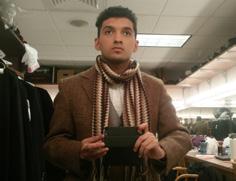
Community colleges have advisers and counselors on campus, who help international students tailor their programs and assimilate to a new style of education.Paromita Pain is an assistant professor of Global Media Studies at the University of Nevada, Reno. Rushil Sharma (right) attended Green River College (above right), where he discovered his talents in extracurriculars, including dramatics. Courtesy Green River College Courtesy Rushil Sharma
Can clean energy be made more affordable and universally accessible? How can novice users of artificial intelligence (AI) understand it better? Can medical diagnosis be made more efficient?
These are some of the questions three Indian Quad fellows—Teja Venkatesa Perumal, Dhruv Agarwal and Sharicka Zutshi are exploring. They are part of the first cohort of 100 fellows announced in December 2022.
Designed to build ties among the next generation of scientists and technologists, the Quad Fellowship is an initiative of the governments of the four Quad countries—Australia, India, Japan and the United States. The fellows receive $50,000 in funding, which can be used for tuition, research, books or other related academic expenses.
While pursuing their higher studies in the United States, Perumal, Agarwal and Zutshi will participate in the Quad cohort’s networking activities and virtual programming. “The Quad Fellowship not only allows me to fund a part of my graduate school journey,” says Zutshi, “but also allows me to interact with scientists and change-makers from across the Quad countries, which will help me develop as a scientist, innovator, future educator and aspiring entrepreneur.”
Agarwal, too, says he will use the benefits of
Above: The Quad Fellowship is an initiative of the governments of the four Quad countries—Australia, India, Japan and the United States. The first cohort of 100 fellows was announced in December 2022.

Indian Quad fellows use their STEM education to find innovative solutions for social good.Courtesy Teja Venkatesa Perumal
the fellowship to support his research.
“Apart from funding for my fieldwork, the programmatic and networking benefits will help me diversify my research into underserved communities in different countries, something I would not be able to do otherwise,” he says. “As a result of these benefits, I will end up delivering quality STEM research focused on social good.”
A first-year Ph.D. student at Cornell University, Agarwal uses his background in computer science and human-computer interaction to design, build and evaluate technologies for underserved communities.

“Currently, my focus is on designing fair and responsible AI for marginalized individuals, especially in the context of health care,” he says. “My research will center on creating AI products that can be easily understood by users with limited resources, allowing them to make informed decisions about when to trust or distrust AI.”
Agarwal’s latest project at Cornell University seeks to understand how community health care workers in India understand the output of an AI-powered health diagnostic application. The project team found that these users place immense trust in the AI output, treating it similarly to output from diagnostic devices like thermometers or X-ray machines. “As technical users, we understand that AI is nebulous and can make mistakes, but users with low levels of AI literacy are unable to fathom uncertainty in a machine’s output,” he says. “We are now using insights from this
study to build AI applications that are more interpretable to novice AI users.”
Agarwal, who is from New Delhi, arrived in the United States in the fall of 2022. During his Ph.D. studies over five years, he hopes to build an understanding of the needs and problems faced by underserved communities around the world that may be tackled by technology.
“After my Ph.D.,” he says “I want to continue designing and building technologies that bring social and policy impact, which is why the Quad Fellowship is a great fit for my long-term goals.”
A fourth-year undergraduate student, Zutshi is studying bioengineering and design innovation at the University of California (UC), Berkeley.
She is also working as a research assistant at the Sohn Research Lab in the UC Berkeley Department of Mechanical Engineering. Among other things, she is working on project ideas in early cancer detection and late-stage cancer adjuvant therapy— additional cancer treatment given after the primary treatment to lower the risk of the cancer coming back.
“Throughout my educational journey, my primary academic interests have been science, technology, economics and public policy,” says Zutshi, who was born in Bengaluru and completed school in Mumbai. Starting at an early age, she became interested in bioinspired design and its different applications.
“Growing up in a country with a 1:1000

doctor-to-patient ratio, I was determined to make a difference in India’s health care infrastructure. Consequently, I was most intrigued by the applications of bioinspired design in medical science,” she says.
One problem she hopes to address is the lack of access to affordable health care in low-resource settings. “Specifically, I hope to work toward creating innovative solutions to improve the efficiency of medical devices used for health care delivery to reduce the burden on doctors and medical care systems,” says Zutshi.
She hopes to do so by exploring the use of microfluidic devices as diagnostic and therapeutic tools. Also called lab-on-achip, microfluidic devices use very small amounts of fluid on a microchip to do certain laboratory tests.
Zutshi believes that health care delivery can be improved through strategic innovation, specifically in diagnostic protocols for conditions like cancer. “By reducing the time required for diagnosis and subsequently improving treatment access,” she says, “we can save the lives which would be otherwise lost.”
Zutshi, who hopes to explore research, academia and entrepreneurship throughout her career, says her experience of studying in the United States has been incredibly rewarding. “I believe that being academically challenged in an environment that values discussion and debate has helped me grow as a student and an aspiring researcher,” she says. “I am incredibly grateful for the opportunity to learn and grow in such a technology-forward, innovation-oriented country and with an
amazing group of talented individuals from diverse backgrounds.”
Clean energy for all
Perumal, a Ph.D. student at the University of Wisconsin-Madison, works on the sustainable production of valuable chemicals and fuels. This, in turn, makes clean energy more affordable and will have a direct impact on its accessibility. “I develop new catalytic processes and materials to make this possible,” says Perumal. “Specifically, I look at using renewable electricity to enable the conversion of carbon dioxide and the production of organic chemicals of pharmaceutical value.”

Growing up in Chennai, she realized that a lack of universal access to clean energy has compounded the challenges of climate change and poverty. “Scientific research can serve as a vital remedy,” she says. “Therefore, I was keen to carry out research to make clean energy affordable and universally accessible.”
Perumal, who wants to pursue a career in academia and be involved in public service, says she appreciates the numerous opportunities, as part of her Ph.D., to interact with policymakers and industry partners and to work on interdisciplinary and large-scale collaborations.
“I am excited to interact with a wide range of people through the Quad Fellowship,” she says, “especially those working on crucial governmental policies and also key industry players.”
The Quad Fellowship is designed to build ties among the next generation of scientists and technologists.
